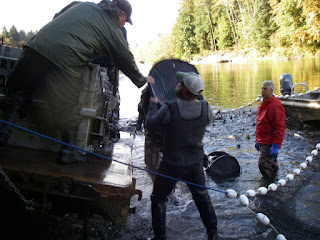September is the time the Nitinat Hatchery takes
chinook brood stock to be milked into pails of shining red eggs. This year,
when the time came, there had been enough rain that available chinook had taken
to the river, rather than need to be netted in the Lake near the First Nation
town of Ditidaht.
The three major hatcheries – the Nitinat, Robertson
Creek and Conuma – on Van Isle’s West Coast have had reduced numbers of
returnees this year, with only 7,000 for the Nitinat, when last year’s figure,
was nearer to 20,000 if my memory is correct. Last year, fish were evenly
seeded from bottom to top of the river, and I released many from top to bottom,
most of which were fat and happy 25- to 35-pound fish (i.e., a greater than
usual number of five-year-old fish).
Typically, one catches chinook with a dink float setup
and the wool at fish eye level gets mouthed as it passes. It is not usual for
chinook to take spinners and spoons, but last year there were many takers, meaning
the fish were willing to detach themselves from the school and chase down the
lure. This past week, I was fishing in the pool below Red Rock when I heard the
unmistakable sound of a jet boat. I had just finished landing a beautiful
female 13-pound, hatchery coho and though it was hooked by the skin of its
teeth, it stayed on the line long enough for me to make the hundred-yard trek
to shore.
Thence a proper cleaning to keep it fresh, and then
stuck in knee deep water with a long stick into the gravel so the shady
seagulls did not take to it. I waded back to waist deep water. Swell, I
thought, I sure hope they don’t fish here. With visions of been swamped by a
wake and with my fish scattered, I cast back out in hopes of another fish
before boatageddon.
After five minutes and lots of hollering from the boat,
which I assumed meant that a healthy amount of Lucky had been consumed before
8:00 AM, it dawned on me that the boat wasn’t coming down straight at me, but
was doing something in Red Rock Pool. A few minutes later, I realized it was
the hatchery guys come to collect brood stock.
When I wandered up to the boat launch, sure enough,
they had corralled hundreds of fish and the net was slowly pulled in to the
boat launch, effectively concentrating the fish in a very small space. The
process of capturing the fish proved very interesting to watch.
Someone with a sure grip because of the special stubbly
gloves that were worn, nabbed the fish by the anal peduncle, or the wrist of
the tail, then the fish was sloooshed into a fish tube (mesh ends to let water
rush in or drain out) with a zipper that closed, and the tube, diameter of 24
inches and 5 feet long, was placed in a row in the water, close to where the
trucks pulled in.
The trucks have containers that look a couple of
hundred gallons each, with air bubbled in for O2. Once about ten fish tubes were lined up with fish
in them in the shallows, two groups of two guys, would lift the water- and fish-filled
bags up one at a time, in one movement to chest level, water cascading over
everyone, then two guys on the truck grabbed the bag and emptied the fish into
the tank.
I believe the truck held 20 to 40 fish, sex recorded
by an enumerator who was as wet as everyone else, so they could reach their
needed numbers. Volunteers for Sooke, along with Sarita helped the chore, a
very labour, meaning muscle, intensive exercise. And great humour that the fish
nabber, got the old face wash dozens of times while tracking down the best
fish.
The other fish nabbed by the fine mesh net included
coho, which a volunteer kept a few for himself. As I was taking video and
stills, I didn’t want to get close enough to ask for one for myself to complete
my limit, largely because I thought I would be thrust a fish and detailed into
helping everyone else. I was a civilian by my reckoning and recording the act
for posterity had its own value.
I have put four videos on Dropbox, and anyone who
wants a link to view them, just send me an email and you can take a look at
what once the deed is done, if it weren’t filmed, was not recorded for everyone
to see. A shame for such a neat example of what we do in BC to help salmon.
The trucks, once loaded, sloshed their way to the
hatchery, several miles a way, where I believe they were put back in water to
be held to maturity and then spawned. Then the trucks trundled back to a line
of waiting fish tubes and their salmon. Other fish included some Coho and
Chinook Jacks, a few cutthroat and a slew of Jimmies, as the hatchery calls
one-year 2015 chinook males that spent time in the lake/estuary and came back
in with the mature fish. They look like a cross between a pink salmon and
chinook - brown spots on body and tail, but lots of teeth in a black mouth and the unmistakable
smell of a chinook.
Here are some shots:
Fish cornered in the net:
Fish in the water and loaded into fish tubes:
Fish loaded into the truck tank:
More fish loaded into the truck tank:
A fine catch of fresh Diet Coke:






No comments:
Post a Comment